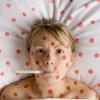CYBERMED LIFE - ORGANIC & NATURAL LIVING
CYBERMED LIFE - ORGANIC & NATURAL LIVING
 Measles Infection: Measles is a highly contagious infectious disease caused by the measles virus. Symptoms usually develop 10–12 days after exposure to an infected person and last 7–10 days. Initial symptoms typically include fever, often greater than 40 °C (104.0 °F), cough, runny nose, and inflamed eyes. Small white spots known as Koplik's spots may form inside the mouth two or three days after the start of symptoms. A red, flat rash which usually starts on the face and then spreads to the rest of the body typically begins three to five days after the start of symptoms. Complications occur in about 30% of cases and may include diarrhea, blindness, inflammation of the brain, and pneumonia, among others. Rubella, which is sometimes called German measles, and roseola are different diseases caused by unrelated viruses.
Measles Infection: Measles is a highly contagious infectious disease caused by the measles virus. Symptoms usually develop 10–12 days after exposure to an infected person and last 7–10 days. Initial symptoms typically include fever, often greater than 40 °C (104.0 °F), cough, runny nose, and inflamed eyes. Small white spots known as Koplik's spots may form inside the mouth two or three days after the start of symptoms. A red, flat rash which usually starts on the face and then spreads to the rest of the body typically begins three to five days after the start of symptoms. Complications occur in about 30% of cases and may include diarrhea, blindness, inflammation of the brain, and pneumonia, among others. Rubella, which is sometimes called German measles, and roseola are different diseases caused by unrelated viruses.
Measles is an airborne disease which spreads easily through the coughs and sneezes of infected people. It may also be spread through contact with saliva or nasal secretions. Nine out of ten people who are not immune and share living space with an infected person will catch it. People are infectious to others from four days before to four days after the start of the rash. Most people do not get the disease more than once. Testing for the measles virus in suspected cases is important for public health efforts.
The measles vaccine is effective at preventing the disease, and is often delivered in combination with other vaccines. Vaccination has resulted in a 75% decrease in deaths from measles between 2000 and 2013, with about 85% of children worldwide being currently vaccinated. Once a person has become infected, no specific treatment is available, but supportive care may improve outcomes. This may include giving oral rehydration solution (slightly sweet and salty fluids), healthy food, and medications to control the fever. Antibiotics may be used if a secondary bacterial infection such as pneumonia occurs. Vitamin A supplementation is also recommended in the developing world.
Measles affects about 20 million people a year, primarily in the developing areas of Africa and Asia. No other vaccine-preventable disease causes as many deaths. In 1980, 2.6 million people died of it, and in 1990, 545,000 died; by 2014, global vaccination programs had reduced the number of deaths from measles to 73,000. The risk of death among those infected is usually 0.2%, but may be up to 10% in people with malnutrition. Most of those who die from the infection are less than five years old. Measles is not believed to affect other animals. Before immunization in the United States, between three and four million cases occurred each year. As a result of widespread vaccination, the disease was eliminated from the Americas by 2016.